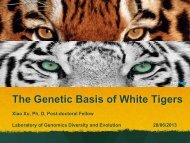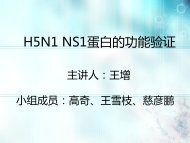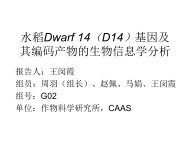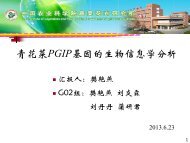Environmental connections of novel avian-origin H7N9 influenza ...
Environmental connections of novel avian-origin H7N9 influenza ...
Environmental connections of novel avian-origin H7N9 influenza ...
You also want an ePaper? Increase the reach of your titles
YUMPU automatically turns print PDFs into web optimized ePapers that Google loves.
Li J, et al. Sci China Life Sci June (2013) Vol.56 No.6 32 Results2.1 Epidemiological and clinical features <strong>of</strong> the cases inHangzhou City, Zhejiang ProvinceEpidemiological and clinical information were collectedfrom the patients’ medical records, as well as from interviewswith them and their relatives. Details <strong>of</strong> the investigationare recorded in Table S1. Patient 1 was a 38-year-oldman with a history <strong>of</strong> hepatitis B virus infection and thepositive hepatitis B surface antigen was detected. The manwas a cook who had visited a poultry market every otherday before the onset <strong>of</strong> his symptoms. He had high feverand cough at the onset <strong>of</strong> the illness. Patient 2 was a67-year-old man who had a history <strong>of</strong> hypertension andnasitis. One week before the onset <strong>of</strong> the symptoms, he hadvisited a free market and bought two live quails which werebutchered in the market. He cooked the quail himself andate some <strong>of</strong> it. No other poultry contact in the two weeksbefore the onset <strong>of</strong> the illness was reported by Patient 2.Patient 2 also had high fever, cough, and sputum productionat the onset <strong>of</strong> the illness. Patient 3 was a 79-year-old man.He had no known history <strong>of</strong> exposure to live birds duringthe two weeks before the onset <strong>of</strong> symptoms. This patienthad a cough and was found to have high fever on admission.The general clinical features <strong>of</strong> the three Hangzhou patientswith confirmed infections <strong>of</strong> the <strong>avian</strong> <strong>influenza</strong> A(<strong>H7N9</strong>) virus were similar to the three cases reported previouslyin Shanghai and in Anhui Province [1]. All threepatients presented with high fever, cough, shortness <strong>of</strong>breath, and a history <strong>of</strong> sputum production. In Patient 1, thesputum was bloodstained, which was not reported in thethree <strong>H7N9</strong> virus infected cases in the previous study [1].None <strong>of</strong> the patients had diarrhea, conjunctivitis, or rash.Physical examination <strong>of</strong> the chest in all three patients revealedrespiratory distress and crackles, and rapid breathingin Patients 1 and 3. The white cell counts were normal forthe three cases. The levels <strong>of</strong> creatine kinase and lactatedehydrogenase were increased in all three patients. Bilateralor unilateral ground-glass opacities and pleural effusionwere observed by chest radiography (Figure 1).Antibiotic therapy combined with glucocorticoids wasadministered to all three patients. Antiviral therapy and intravenousimmunoglobulin were given to Patients 2 and 3.Patient 1 was admitted to the intensive care unit and intubatedseven days after admission. Pneumonedema and acuterespiratory distress syndrome developed in this patient andhe died on day 21 after the onset <strong>of</strong> his illness. Patients 2and 3 were transferred to negative pressure wards after thelaboratorial confirmation <strong>of</strong> the <strong>H7N9</strong> infection and theirvital signs gradually improved.2.2 Causative pathogen <strong>of</strong> the infections and the environmentalconnectionThe RT-PCR and sequencing results for the amplified PCRproducts confirmed that <strong>H7N9</strong> <strong>influenza</strong> virus was thecausative agent <strong>of</strong> the illness and death for Patient 1. ForPatients 2 and 3, the infection <strong>of</strong> <strong>influenza</strong> A (<strong>H7N9</strong>) viruswas confirmed by real-time RT-PCR. The RT-PCR andsequence confirmed-viruses identified in Hangzhou fromPatients 1, 2 and 3 were named A/Hangzhou/1/2013 (<strong>H7N9</strong>)(Hangzhou/1), A/Hangzhou/2/2013(<strong>H7N9</strong>) (Hangzhou/2)and A/Hangzhou/3/2013(<strong>H7N9</strong>) (Hangzhou/3), respectively.<strong>Environmental</strong> specimens related to Patient 2 were alsotested. Poultry cage swabs and feces from the free marketthat Patient 2 visited one week before the onset <strong>of</strong> thesymptoms were positive for the <strong>novel</strong> <strong>avian</strong> <strong>influenza</strong> A(<strong>H7N9</strong>) virus. We named this environmental virus A/environment/Hangzhou/34/2013(<strong>H7N9</strong>)(Env/Hangzhou).2.3 Sequence diversity <strong>of</strong> <strong>H7N9</strong> Hangzhou virusesA phylogenic tree was constructed after aligning multipleH7 sequences from the Hangzhou viruses and from otherFigure 1 Chest radiographs. A, Computed tomography scan <strong>of</strong> the chest <strong>of</strong> Patient 1 was obtained on day 6 after the onset <strong>of</strong> the illness. Consolidation <strong>of</strong>inferior lobe <strong>of</strong> right lung and bilateral patches <strong>of</strong> higher density shadow can be seen. B, Chest radiographs <strong>of</strong> Patient 1 on day 11. Bilateral ground-glassopacity and consolidation can be seen.
















